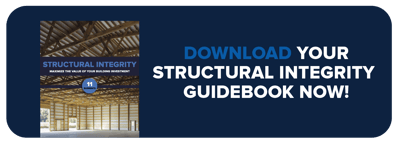Posts | Building Features | Structural Integrity
6 Types of Lumber Used in Pole Barn Construction
Cori grew up on her family's small grain and livestock operation in Northwest Indiana. In 2018, she graduated Summa Cum Laude with a Bachelor's degree in Business Administration & Marketing from Marian University Indianapolis. Having shown beef cattle for 12 years at the county, state, and national levels, Cori chose to pursue a career in agriculture. Today, she serves as the Marketing Content Creator on the FBi team. In her free time, Cori enjoys spending time with family and friends, watching sports, listening to live music, and traveling.
If you’re an active follower of the FBi Learning Center, then you know that we heavily stress the importance of pole barn structural integrity. We’ve discussed multiple wooden building components and their role in the load path:
We’ve also covered the different lumber treatments that prevent rot, specifically Chromated Copper Arsenate (CCA) versus Alkaline Copper Quaternary (ACQ).
However, we haven’t gone into great detail regarding the six specific types of wood used in post-frame construction…until now.
Furthermore, this article explains the difference between lumber species and grade, which plays a factor in the wood application.
What is a Lumber Species?
As you’re well aware, lumber is a byproduct of harvested trees. But, did you know that lumber is classified into two groups: softwood and hardwood?
Editor’s Note: The terms “softwood” and “hardwood” refer to the tree distinction, not lumber performance.
Softwood Lumber
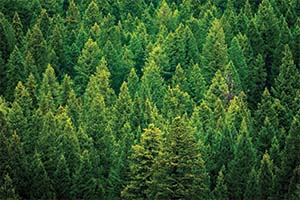 First, softwoods (i.e., gymnosperms) come from coniferous trees. This species consists of cones and needles rather than leaves. They don’t lose their cones or needles in the fall and remain dormant during winter.
First, softwoods (i.e., gymnosperms) come from coniferous trees. This species consists of cones and needles rather than leaves. They don’t lose their cones or needles in the fall and remain dormant during winter.
Softwood trees grow faster than hardwood trees, making their supply relatively abundant. Moreover, they’re lightweight and have a straighter grain. These characteristics are perfect for use as building materials in post-frame construction.
The most common types of softwood lumber include:
- Cedar
- Fir
- Pine
- Redwood
- Spruce
Hardwood Lumber
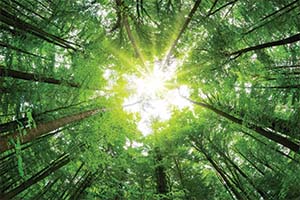 Second, hardwoods (i.e., angiosperms) come from deciduous trees. This species flowers in the spring and loses its leaves in the fall.
Second, hardwoods (i.e., angiosperms) come from deciduous trees. This species flowers in the spring and loses its leaves in the fall.
Hardwood trees have large vessels for water intake and giant surface pores that create interesting wood grains. In addition, their density is much higher than softwood trees, increasing durability and strength. These attributes are ideal for cabinetry, flooring, furniture making, and other woodworking projects.
As mentioned above, hardwood trees grow slower than softwood trees. Consequently, their supply is limited, thus, increasing costs.
The most common types of hardwood lumber include:
- Ash
- Beech
- Cherry
- Hickory
- Mahogany
- Maple
- Oak
- Walnut
What is a Lumber Grade?
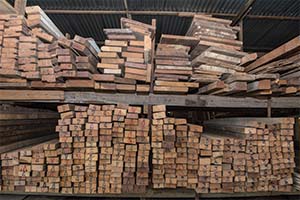 Next, lumber is visually and mechanically “graded” for quality purposes. Although, there are separate grading systems for softwoods and hardwoods.
Next, lumber is visually and mechanically “graded” for quality purposes. Although, there are separate grading systems for softwoods and hardwoods.
Since we’re a post-frame builder, this blog focuses on softwood lumber grades:
- Appearance
- Non-stress
- Stress
Appearance lumber grades are based on the visual quality of the wooden member, whereas non-stress and stress lumber grades are concerned with structural integrity.
Stress lumber grades are critical to load-bearing building components. Examples include beams, joists, posts, rafters, and studs. These ratings show how the wood fibers can handle bending, compressive, tensile, and shear stresses. Again, they may be determined visually or mechanically according to ASTM standards.
6 Types of Wood Used in Post-Frame Construction
While there are multiple lumber species, we focus on the most common types of wood used in post-frame construction. Most pole barn builders implement the following lumber species into the building design (but are certainly not limited to):
1. Southern Yellow Pine (SYP)
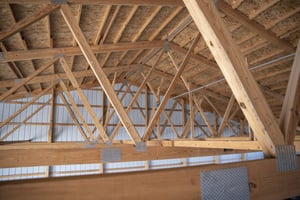 Southern Yellow Pine (SYP) is one of the top softwood lumber species. Its roots (no pun intended) come from the southern United States, hence the name.
Southern Yellow Pine (SYP) is one of the top softwood lumber species. Its roots (no pun intended) come from the southern United States, hence the name.
This pine species is durable and dense – an excellent choice for agricultural, commercial, and residential construction. Nails and screws fasten and hold very well.
Additionally, SYP has a unique cellular structure ideal for pressure treatment. It makes up 85% of all pressure-treated wood in the United States. Plus, its grain pattern and golden hue are a natural beauty.
Many construction companies, including FBi Buildings, use Southern Yellow Pine lumber for truss manufacturing and framing purposes.
Southern Yellow Pine is available in several grades and board sizes. Common grades for SYP include #1, #2, #3, #4, decking, dense structural, machine stress-rated (MSR), prime, and timber. Generally, we use SYP #1 for truss webs and SYP MSR2400 for headers and truss chords.
2. Spruce-Pine-Fir
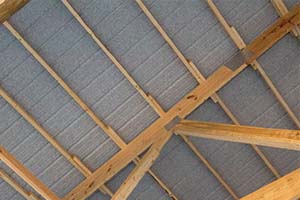 Spruce-Pine-Fir (SPF) is a wood combination of Engelmann Spruce, Lodgepole Pine, and Subalpine Fir. This lumber species comes from coniferous trees in the northern United States (and Canada).
Spruce-Pine-Fir (SPF) is a wood combination of Engelmann Spruce, Lodgepole Pine, and Subalpine Fir. This lumber species comes from coniferous trees in the northern United States (and Canada).
SPF is well-known for being lightweight and versatile. In addition, the wooden surface is smooth, perfect for interior finishing (e.g., drywall).
Unlike Southern Yellow Pine, Spruce-Pine-Fir isn’t pressure-treated. Instead, the boards are kiln-dried, providing extra strength and resistance to warping.
The following SPF lumber grades are used in post-frame construction: #2, #3, economy, machine stress-rated, and stud. At FBi Buildings, we specifically use SPF #2 (roof purlins) and SPF MSR1650 (sidewall girts).
3. Engineered Wood Products
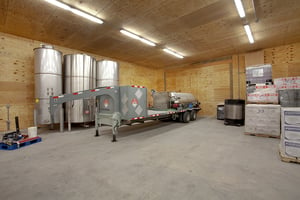 Post-frame builders use various engineered wood products inside their pole barns. These building materials consist of real wood, scrap, shredded fibers, and sawdust bound with adhesive.
Post-frame builders use various engineered wood products inside their pole barns. These building materials consist of real wood, scrap, shredded fibers, and sawdust bound with adhesive.
They look and act like lumber but are designed to be more durable than standard softwoods. Often, engineered wood products are used as interior finishes.
For an in-depth look at the pros and cons of each type, we recommend reading “6 Ways to Finish the Interior of Your Pole Barn.”
Plywood
Plywood contains thin layers, also known as plies, glued together in a cross-grain pattern. This design increases strength, resisting shrinkage and expansion caused by moisture. The engineered wood product is popular in post-frame construction because of its robustness and relatively low cost.
Oriented Strand Board (OSB)
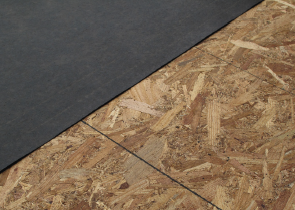 Oriented strand board (OSB) is made of mixed hardwood and softwood strands. Board sizes range up to 12’ long. Typically, OSB is installed underneath another building material (e.g., steel).
Oriented strand board (OSB) is made of mixed hardwood and softwood strands. Board sizes range up to 12’ long. Typically, OSB is installed underneath another building material (e.g., steel).
Laminated Veneer Lumber (LVL)
Laminated veneer lumber (LVL) is a widely used engineered wood product in post-frame construction. It’s manufactured from multiple thin layers of veneer that fit the length of the finished board.
At FBi Buildings, we use LVLs for headers and rafters (specifically lean-tos). Other applications include beams, joists, and trusses.
4. Cedar
Cedar is a popular type of softwood used in post-frame construction. Because of its natural beauty, this lumber species is meant to improve aesthetics (not intended for structural use). Cedar doesn’t decay, shrink, swell, or warp. It even absorbs noise!
5. Douglas Fir (DF-L)
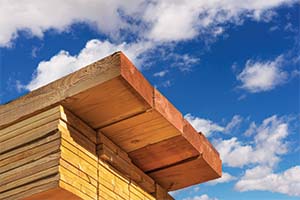 Douglas fir (DF-L) is one of the most durable softwoods, especially when exposed to the elements. This lumber species is a native of the Pacific Northwest region (e.g., Oregon and Washington). DF-L is resistant to water damage, which contributes to premature aging in wood.
Douglas fir (DF-L) is one of the most durable softwoods, especially when exposed to the elements. This lumber species is a native of the Pacific Northwest region (e.g., Oregon and Washington). DF-L is resistant to water damage, which contributes to premature aging in wood.
Furthermore, Douglas Fir is well-known for its structural properties. In fact, “DF-L has the highest ratings of any Western softwood for fiber stress in bending, tension parallel to the grain, horizontal shear, compression perpendicular, and compression parallel to the grain.”
Douglas Fir also grades well in appearance with its light rosy hue and grain pattern.
6. Hem-Fir
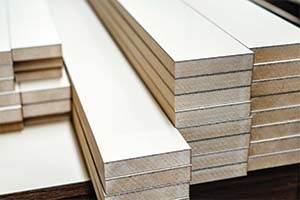 Lastly, Hem-Fir is a wooden combination of Western Hemlock and true firs (Noble, California Red, Grand Pacific Silver, and White Fir).
Lastly, Hem-Fir is a wooden combination of Western Hemlock and true firs (Noble, California Red, Grand Pacific Silver, and White Fir).
Unlike Douglas Fir, Hem-Fir is susceptible to moisture and insect infestation when left untreated. Therefore, we highly recommend purchasing pressure-treated boards.
It’s still a strong building material (ranked slightly below DF-L) and can be used in multiple framing applications.
Hem-Fir products range from white to a light straw color. This softwood is fine-grained and even-textured with a refined appearance.
Are You Ready to Move Forward with Your Pole Barn Project?
As one of the top post-frame builders in the Midwest, we hope you better understand lumber species, their grades, and their applications. Each type plays a significant role in carrying structural loads from the roof to the foundation.
For more information about load-bearing building components, you can download our FREE “Structural Integrity in Post-Frame Construction” e-book.
Do you want to request a quote? Then, submit your building design to our sales team to begin the estimating process.
Do you have more questions that aren’t covered in this article? If you need help designing and planning, please contact FBi Buildings at 800.552.2981 or click here to email us. If you’re ready to get a price, click here to request a quote, and a member of our Customer Engagement Team will help you determine the next steps.

